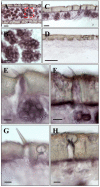The olfactory co-receptor Orco from the migratory locust (Locusta migratoria) and the desert locust (Schistocerca gregaria): identification and expression pattern
- PMID: 22211114
- PMCID: PMC3248701
- DOI: 10.7150/ijbs.8.159
The olfactory co-receptor Orco from the migratory locust (Locusta migratoria) and the desert locust (Schistocerca gregaria): identification and expression pattern
Abstract
In locusts, olfaction plays a crucial role for initiating and controlling behaviours, including food seeking and aggregation with conspecifics, which underlie the agricultural pest capacity of the animals. In this context, the molecular basis of olfaction in these insects is of particular interest. Here, we have identified genes of two orthopteran species, Locusta migratoria and Schistocera gregaria, which encode the olfactory receptor co-receptor (Orco). It was found that the sequences of LmigOrco and SgreOrco share a high degree of identity to each other and also to Orco proteins from different insect orders. The Orco-expressing cells in the antenna of S. gregaria and L. migratoria were visualized by in situ hybridization. Orco expression could be assigned to clusters of cells in sensilla basiconica and few cells in sensilla trichodea, most likely representing olfactory sensory neurons. No Orco-positive cells were detected in sensilla coeloconica and sensilla chaetica. Orco expression was found already in all nymphal stages and was verified in some other tissues which are equipped with chemosensory hairs (mouthparts, tarsi, wings). Together, the results support the notion for a decisive role of Orco in locust olfaction.
Keywords: Orco; gene expression; in situ hybridization.; locust; olfaction.
Conflict of interest statement
Conflict of Interests: The authors have declared that no conflict of interest exists.
Figures






Similar articles
-
In Search for Pheromone Receptors: Certain Members of the Odorant Receptor Family in the Desert Locust Schistocerca gregaria (Orthoptera: Acrididae) Are Co-expressed with SNMP1.Int J Biol Sci. 2017 Jul 15;13(7):911-922. doi: 10.7150/ijbs.18402. eCollection 2017. Int J Biol Sci. 2017. PMID: 28808423 Free PMC article.
-
Variant ionotropic receptors are expressed in olfactory sensory neurons of coeloconic sensilla on the antenna of the desert locust (Schistocerca gregaria).Int J Biol Sci. 2013 Dec 1;10(1):1-14. doi: 10.7150/ijbs.7624. eCollection 2013. Int J Biol Sci. 2013. PMID: 24391446 Free PMC article.
-
Differential expression of two novel odorant receptors in the locust (Locusta migratoria).BMC Neurosci. 2013 Apr 22;14:50. doi: 10.1186/1471-2202-14-50. BMC Neurosci. 2013. PMID: 23607307 Free PMC article.
-
Peptides in the locusts, Locusta migratoria and Schistocerca gregaria.Peptides. 1997;18(1):145-56. doi: 10.1016/s0196-9781(96)00236-7. Peptides. 1997. PMID: 9114464 Review.
-
Towards an understanding of the structural basis for insect olfaction by odorant receptors.Insect Biochem Mol Biol. 2015 Nov;66:31-41. doi: 10.1016/j.ibmb.2015.09.010. Epub 2015 Sep 28. Insect Biochem Mol Biol. 2015. PMID: 26416146 Review.
Cited by
-
Molecular characterization and immunolocalization of the olfactory co-receptor Orco from two blood-feeding muscid flies, the stable fly (Stomoxys calcitrans, L.) and the horn fly (Haematobia irritans irritans, L.).Insect Mol Biol. 2013 Apr;22(2):131-42. doi: 10.1111/imb.12009. Epub 2013 Jan 1. Insect Mol Biol. 2013. PMID: 23278866 Free PMC article.
-
The Two Main Olfactory Receptor Families in Drosophila, ORs and IRs: A Comparative Approach.Front Cell Neurosci. 2018 Aug 30;12:253. doi: 10.3389/fncel.2018.00253. eCollection 2018. Front Cell Neurosci. 2018. PMID: 30214396 Free PMC article. Review.
-
Molecular characterization and expression of sensory neuron membrane proteins in the parasitoid Microplitis mediator (Hymenoptera: Braconidae).Insect Sci. 2020 Jun;27(3):425-439. doi: 10.1111/1744-7917.12667. Epub 2019 Mar 14. Insect Sci. 2020. PMID: 30779304 Free PMC article.
-
In Search for Pheromone Receptors: Certain Members of the Odorant Receptor Family in the Desert Locust Schistocerca gregaria (Orthoptera: Acrididae) Are Co-expressed with SNMP1.Int J Biol Sci. 2017 Jul 15;13(7):911-922. doi: 10.7150/ijbs.18402. eCollection 2017. Int J Biol Sci. 2017. PMID: 28808423 Free PMC article.
-
Localization of Odorant Receptor Genes in Locust Antennae by RNA In Situ Hybridization.J Vis Exp. 2017 Jul 13;(125):55924. doi: 10.3791/55924. J Vis Exp. 2017. PMID: 28745638 Free PMC article.
References
-
- Lomer CJ, Bateman RP, Johnson DL, Langewald J, Thomas M. Biological control of locusts and grasshoppers. Annu Rev Entomol. 2001;46:667–702. - PubMed
-
- Hassanali A, Njagi PG, Bashir MO. Chemical ecology of locusts and related acridids. Annu Rev Entomol. 2005;50:223–45. - PubMed
-
- Ochieng SA, Hansson BS. Responses of olfactory receptor neurones to behaviourally important odours in gregarious and solitarious desert locust, Schistocerca gregaria. Physiol Entomol. 1999;24:28–36.
-
- Cui X, Wu C, Zhang L. Electrophysiological response patterns of 16 olfactory neurons from the trichoid sensilla to odorant from fecal volatiles in the locust, locusta migratoria manilensis. Arch Insect Biochem Physiol. 2011;77:45–57. - PubMed
-
- Ochieng SA, Hallberg E, Hansson BS. Fine structure and distribution of antennal sensilla of the desert locust, Schistocerca gregaria (Orthoptera: Acrididae) Cell Tissue Res. 1998;291:525–36. - PubMed
Publication types
MeSH terms
Substances
Associated data
- Actions
- Actions
LinkOut - more resources
Full Text Sources
Other Literature Sources

